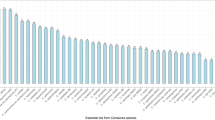Abstract
The chemical composition and antimicrobial potential of Cistus munbyi essential oil were studied for the first time. GC and GC–MS analysis revealed 48 compounds representing 96.98% of the oil. Terpinen-4-ol (23.75%), meta-Cymene (17.30%), and Sabinene (12.38%) were the major constituents. Antimicrobial activity was evaluated against nine pathogens using the disc diffusion and broth micro-dilution methods. Results show that C. munbyi essential oil possesses strong antimicrobial activity against all strains, regardless if Gram-positive or Gram-negative bacteria, or yeast, with MICs values not exceeding 10 (mg/ml). In addition to its efficacy, C. munbyi essential oil has an unusual antimicrobial potency which is attributed to its specific chemical composition. Thus, findings presented here suggest that endemic C. munbyi contains a very interesting essential oil that may be valuable in several areas.

Similar content being viewed by others
References
Adams RP (2007) Identification of essential oil components by gas chromatography/mass spectrometry, 4th edn. Allured publishing corporation, Carol Stream
Bauer AW, Kirby WM, Sherris JC, Turck M (1966) Antibiotic susceptibility testing by a standardized single disk method. Am J Clin Pathol 45(4):493–496
Benbelaïd F, Khadir A, Abdoune MA, Bendahou M, Muselli A, Costa J (2014) Antimicrobial activity of some essential oils against oral multidrug-resistant Enterococcus faecalis in both planktonic and biofilm state. Asian Pac J Trop Biomed 4(6):463
Benchaar C, Calsamiglia S, Chaves AV, Fraser GR, Colombatto D, McAllister TA, Beauchemin KA (2008) A review of plant-derived essential oils in ruminant nutrition and production. Anim Feed Sci Technol 145(1–4):209–228
Burt S (2004) Essential oils: their antibacterial properties and potential applications in foods—a review. Int J Food Microbiol 94(3):223–253
Carson C, Hammer K, Riley T (2006) Melaleuca alternifolia (tea tree) oil: a review of antimicrobial and other medicinal properties. Clin Microbiol Rev 19(1):50–62
Cheng VC, To KK, Li IW, Tang BS, Chan JF, Kwan S, Mak R, Tai J, Ching P, Ho PL, Seto WH (2009) Antimicrobial stewardship program directed at broad-spectrum intravenous antibiotics prescription in a tertiary hospital. Eur J Clin Microbiol Infect Dis 28(12):1447–1456
CLSI (2006) Performance standards for antimicrobial disk susceptibility tests. Clin Lab Stand Inst 26(1):1–35
CLSI (2010) Performance standards for antimicrobial susceptibility testing. Clin Lab Stand Inst 30(1):1–153
European-Pharmacopoeia (2005) 5th edn (5.0). Council of Europe, Strasbourg
Guzmán B, Vargas P (2005) Systematics, character evolution, and biogeography of Cistus L. (Cistaceae) based on ITS, trnL-trnF, and matK sequences. Mol Phylogenet Evol 37(3):644–660
Hammer KA, Carson CF, Riley TV (2012) Effects of Melaleuca alternifolia (tea tree) essential oil and the major monoterpene component terpinen-4-ol on the development of single- and multistep antibiotic resistance and antimicrobial susceptibility. Antimicrob Agents Chemother 56(2):909–915
Högberg LD, Heddini A, Cars O (2010) The global need for effective antibiotics: challenges and recent advances. Trends Pharmacol Sci 31(11):509–515
Jadhav S, Shah R, Bhave M, Palombo EA (2013) Inhibitory activity of yarrow essential oil on Listeria planktonic cells and biofilms. Food Control 29(1):125–130
Kalemba D, Matla M, Smętek A (2012) Antimicrobial activities of essential oils. In: Patra AK (ed) Dietary phytochemicals and microbes. Springer, Amsterdam, pp 157–183
Kavanaugh NL, Ribbeck K (2012) Selected antimicrobial essential oils eradicate Pseudomonas spp. and Staphylococcus aureus biofilms. Appl Environ Microbiol 78(11):4057–4061
Khadir A, Bendahou M, Benbelaid F, Abdoune M, Abdelouahid D (2013) Antimicrobial power of Thymus lanceolatus Desf., harvested in Algeria. Phytothérapie 11(6):353–358
Kovats VE (1958) Charakterisierung organischer Verbindungen. Teil 1: Retentionsindices aliphatischer Halogenide, Alkohole, Aldehyde und Ketone. Helv Chim Acta 41(7):1915–1932
Krishnaiah D, Sarbatly R, Nithyanandam R (2011) A review of the antioxidant potential of medicinal plant species. Food Bioprod Process 89(3):217–233
Lang G, Buchbauer G (2012) A review on recent research results (2008–2010) on essential oils as antimicrobials and antifungals. A review. Flavour Fragr J 27(1):13–39
Mann C, Cox S, Markham J (2000) The outer membrane of Pseudomonas aeruginosa NCTC 6749 contributes to its tolerance to the essential oil of Melaleuca alternifolia (tea tree oil). Lett Appl Microbiol 30(4):294–297
Miguel MG (2010) Antioxidant and anti-inflammatory activities of essential oils: a short review. Molecules 15(12):9252–9287
Quézel P, Santa S (1962) Nouvelle flore d’Algérie et des régions désertiques méridionales. Editions du Centre National de la Recherche Scientifique, Paris
Saleem M, Nazir M, Ali MS, Hussain H, Lee YS, Riaz N, Jabbar A (2010) Antimicrobial natural products: an update on future antibiotic drug candidates. Nat Prod Rep 27(2):238–254
Silva N, Fernandes Júnior A (2010) Biological properties of medicinal plants: a review of their antimicrobial activity. J Venom Anim Toxins Incl Trop Dis 16(3):402–413
Van Leeuwen M, Slot D, Van der Weijden G (2011) Essential oils compared to chlorhexidine with respect to plaque and parameters of gingival inflammation: a systematic review. J Periodontol 82(2):174–194
Wiegand I, Hilpert K, Hancock REW (2008) Agar and broth dilution methods to determine the minimal inhibitory concentration (MIC) of antimicrobial substances. Nat Protoc 3(2):163–175
Author information
Authors and Affiliations
Corresponding author
Additional information
Project funding: The study is supported by the Ministry of Higher Education and Scientific Research of People’s Democratic Republic of Algeria (Grant No. F02020110081).
The online version is available at http://www.springerlink.com
Corresponding editor: Chai Ruihai
Rights and permissions
About this article
Cite this article
Benbelaïd, F., Khadir, A., Bendahou, M. et al. Composition and antimicrobial activity of Cistus munbyi essential oil: an endemic plant from Algeria. J. For. Res. 28, 1129–1134 (2017). https://doi.org/10.1007/s11676-017-0387-6
Received:
Accepted:
Published:
Issue Date:
DOI: https://doi.org/10.1007/s11676-017-0387-6



